Our journey through Morocco started with a visit to Fez. An authentic Moroccan city with a long history.
Visit Fez: Short introduction
Morocco harbors four Imperial cities. Fez is one of them, together with Marrakech, Meknes & Rabat.
Fez was Morocco’s first capital & was founded by the Idrisid dynasty in the 9th century.
- Most English speakers call the city “Fez”. However, it is just as common to see the name “Fes”, or else the French variant “Fès”.
Although Fez would lose & gain back its title as capital several times in the past, the place has always played a prominent role in Morocco’s history. Serving as a center for politics, business, trade, Islamic education & scholarship. Attracting business men, merchants, artisans & scholars from across the Islamic world.
Nowadays, we can add tourists to this group. A segment that is growing by the year.
- For a longer, yet concise version of the eventful past of the entire country, including the former capital of Fez, go to: History of Morocco
- Besides this short history I’ve prepared another post with general travel tips & ideas for Morocco. Including segments like Getting Around, Personal Safety, Guides & Tours, Weather, Best time to go, Clothing, Shopping, Money. To learn more, go to: Tips & Ideas for your visit to Morocco


Bird-eye view of the city of Fez, by day & by night (Pictures taken from the rooftop of our hotel in the medina).
Fez as a tourist attraction
Fez’ eventful history has resulted in the authentic Moroccan city it is today. A place full of beautiful monuments from the past. Magnificent palaces, madrasas (Islamic schools), mosques & gardens.
Mainly gathered in the city’s old medina – a UNESCO World Heritage site – with its lively, but also unique mysterious vibe. As if you’re walking in ancient times. The perfect spot to lose yourself – literally & figuratively – and observe the local culture & daily rhythm of a historic Islamic city.
Within the medina you’ll find monumental buildings, like the Al-Qarawiyyin Mosque & University, the Bab Bou Jeloud entrance gate, the Al-Attarine Madrasa & many others.
Besides the many attractions Fez itself has to offer, the city is also a comfortable base to visit the surrounding area on day-trips. Unforgettable tours of the countryside.
Like a visit to the wonderful city of Meknes – also an Imperial city – or the Roman ruins of Volubilis. Or else, amazing outdoor experiences in the purest nature – the surrounding mountains of the Middle Atlas or the Sahara desert.
In short, Fez stands for: a colorful local culture, a mysterious labyrinth-like inner city, eventful past, architectural highlights, authentic city life, craftsmanship, commercial enterprise, religious piety, outdoor experiences & pure nature.
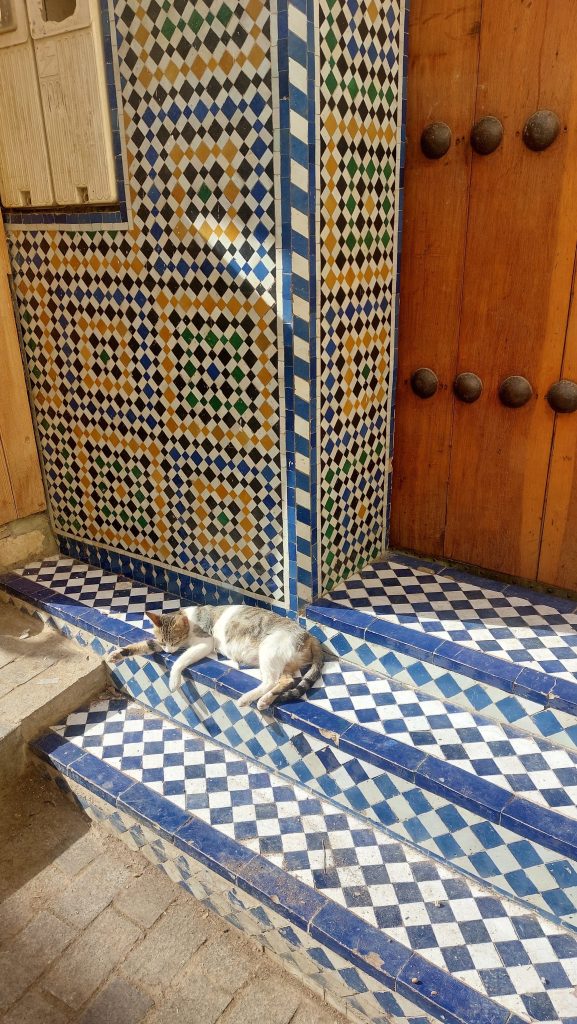
A typical image of the medina of Fez. A cat sleeping on the steps of a tiled doorway.
Important to know, before you read on…
- Throughout this post & others I’ll give you TRAVELTips which may help you plan your upcoming visit to Morocco. Using links provided by affiliate marketing platforms like TravelPayOuts, GetYourGuide & others.
- If you click on them & buy a ticket for a museum, book a tour or rent a bike a small commission of your purchase will go to me (paid by the provider, without any extra cost to you).
- If you want to learn a little bit more about me, the blog writer, click on: Better call me Art.
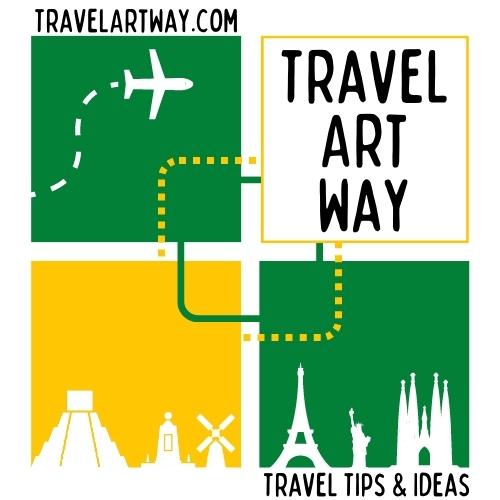
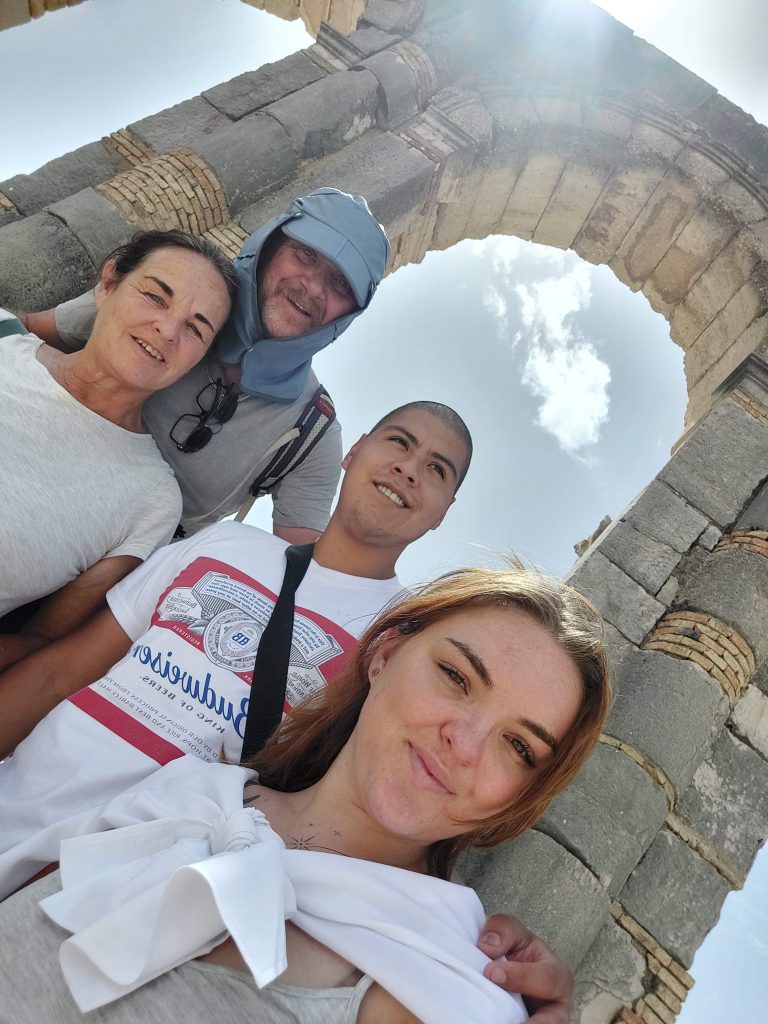
The four of us while visiting the Roman ruins of Volubilis, near Fez.
Main attractions to visit in Fez
There are many attractions you can visit during your stay in Fez. The most popular one being:
A visit to the Medina of Fez
The medina is the top attraction of Fez. A maze of narrow streets (alleyways actually), small squares, shops (souks) & historical monuments, where – besides thousands of local residents – hundreds of artisans continue to practice ancient crafts such as tanning, pottery, metalwork, and carpet weaving.
Navigating through the medina’s vibrant atmosphere and witnessing the traditional way of life is an enchanting journey back in time.







- The Medina of Fez is the largest in Morocco & one of the oldest in the world. It’s a UNESCO World Heritage Site and a must-see & visit for any visitor to Fez. It’s located within the oldest part of the city, the walled center called Fes El Bali.
For us personally a visit to the medina of Fez was a real highlight. Not only of our stay in Fez, but of our whole journey through Morocco. What a magnificent place. A lively, mysterious area, expecting a surprise after every corner, behind every door.
The magic augmented considerably when we – for the first time – from the hotel terrace heard the call to prayer. A sort of melodious song performed by the muezzin who repeats this call several times a day. As there were tens of minarets around us it was a cacophony of sounds. Unforgettable.
- The muezzin reminds Muslims five times a day of their duty to pray. At dawn, noon, midafternoon, sunset & nightfall. According to our local guide, in the medina alone live over 400 000 people.
- Friday is a Holy Day for every muslim. A day of prayer, rest, reflection & being together (for a meal of couscous preferably). Comparable to Sundays in the Christian World.
Hire a guide
The best choice we made was taking a guided tour of the medina the first full day of our visit to Fez. In half a day we saw almost all the historical highlights of the inner city, had a first idea of the people living there, the local culture, the rhythm of life, but also of the most authentic craftwork some artisans still produce.
In short, it was a perfect combination of historical monuments & centuries old craftmanship. The guide knew exactly where to find the most authentic handicrafts. Quality products with their own history, like the old tannery we visited at the end of our tour.
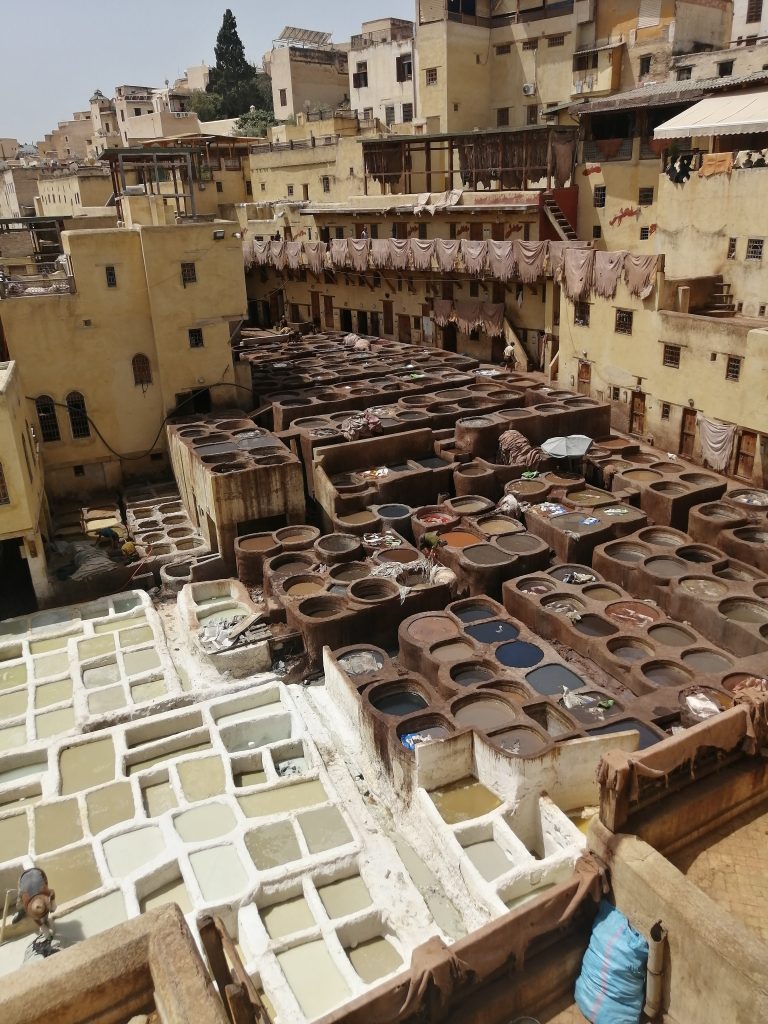
A visit to the world famous tannery of Fez.
In that sense, I’d highly recommend you to book a guided tour of the medina (see below for some options). It’s the only way to really learn to know the ins & outs.
Personal experience
Sure, you can try to find your own way in the medina, but I can guarantee you will get lost! How do I know? We experienced it on our second day in Fez, when we tried to find a certain restaurant (even using a GPS device).
Besides not finding the place, we got totally lost & had no idea how to get back to our hotel.
That’s until a friendly, local guy brought us back (Well, he was waiting for us, obviously a daily occurrence for him).
Following him through a maze of never ending alleyways was an exciting, and – to be honest – a somewhat frightening experience as well. Amazing how this guy made its way through theleft labyrinthine network of the medina. Did he really know the hotel (Riad) we were staying?
- The medina of Fez is the biggest in the world with almost 10 000 alleyways. Quite a few of these alleyways are closed to the public or a dead end. Others are closed off after dark – that is, generally between 8:00 and 9:00pm (depending on the season).
- A local guide told us that a square road sign means the alleyway is open. A hexagonal road sign indicates it’s closed.
In the end we arrived at the hotel – happy & dizzy – paying him some well-deserved Dirhams. An unforgettable experience. Something we will never forget & you will neither.
So, get lost (!), … But not without preparing yourself for a local who will guide you back to your hotel or out of the labyrinth of Fez.
- At the hotel they told us that owners of nearby restaurants & shops are always prepared to pick you up & bring you back if solicited.
Some optional tours
To really get to know the past & present of the medina I’d recommend you to book a guided tour. There are several options:
Click on their names, to learn more:
- A historical walking tour of the medina of Fez
- A food tour, including a visit to the local market & a cooking class
- A shopping tour for authentic local products & souvenirs






Monuments we could admire during our visit to the medina of Fez
Al-Qarawiyyin Mosque/ University & Library
Originally built as a mosque (857-859 AD), this monument was soon converted into an Islamic school. Actually it’s the oldest university in the world & one of the most important religious sites in Morocco.
Unfortunately most of you – like us – can only admire the mosque/university from the outside, as it’s only open to muslims. In other words, we only could get an idea of this amazing building looking through the main gate.
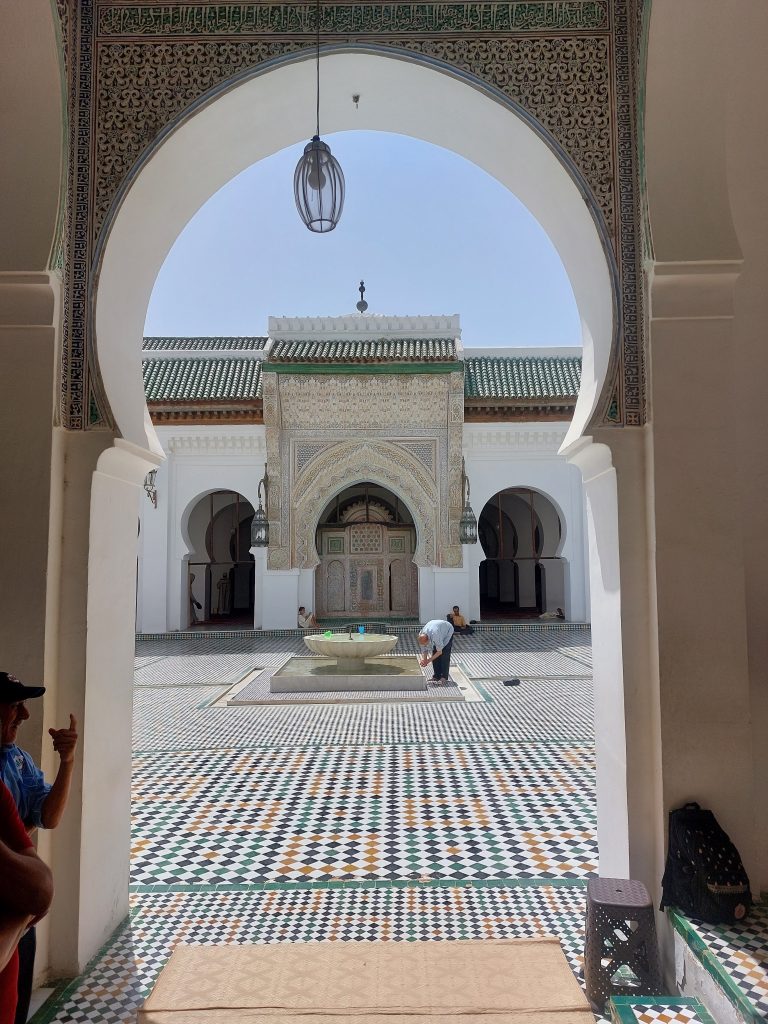
Interior of the Al-Qarawiyyin Mosque/ University, Fez.
Al-Attarine Madrasa
A beautiful 14th century Islamic religious school, left to the city of Fez by the Marinid Dynasty. An impressive building not far from the Al-Qarawiyyin Mosque/ University.






Impressions of the Al-Attarine madrasa, in the medina of Fez.
The Al-Attarine madrasa is one of the finest examples of Marinid-era architecture in Morocco. Mainly known for its colorful tilework, carved stucco arches & cedar wood carvings. On the ground floor you’ll find the impressive central courtyard with a small fountain & a prayer hall.
- Other beautiful religious schools you can visit in Fez are the Bou Inania Madrasa and the Sahrij Madrasa. Both were also built in the 14th century, under Marinid rule.
Fortunately all these madrasas are open to a general public (entrance fee, 20 Dirham), giving you an idea of its interior. Labyrinth-like like the medina itself, with many smaller rooms which mostly served as living quarters for the students.
Chouara Tannery
This is one of the oldest & largest tanneries in the world. Still in use today & most probably on the same spot since the 9th century.
Leatherworks being one of the most valued products Morocco & Fez have to offer its many visitors.
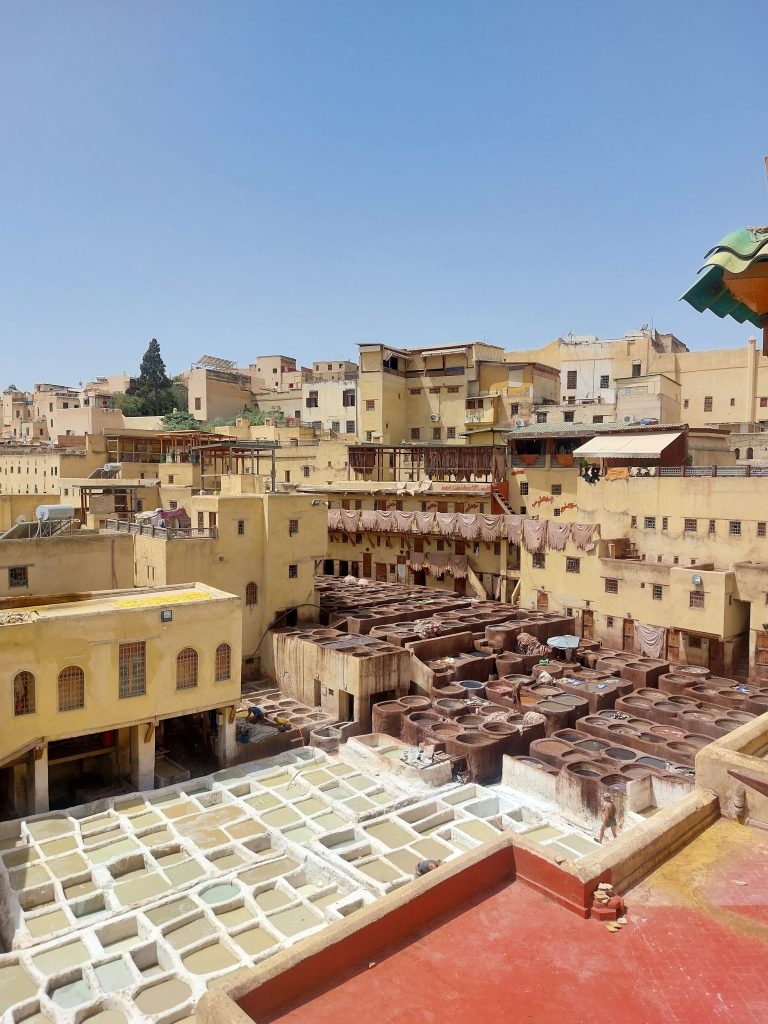
The old tannery of Fez.
WARNING: The smell! As for the first part of the tanning process pigeon droppings are used, the smell is horrendously strong. Strong enough for local guides & sellers to hand out bushes of Mint leaves to make your visit to the tannery of Fez endurable.
Mosque of the Andalusians
This is also a remarkable monument we passed on our tour through the medina. One of the oldest mosques actually in Morocco, built in the 9th century.
The mosque is named after the many immigrants from Andalusia, Spain, who in the past lived mostly in this quarter of the medina.
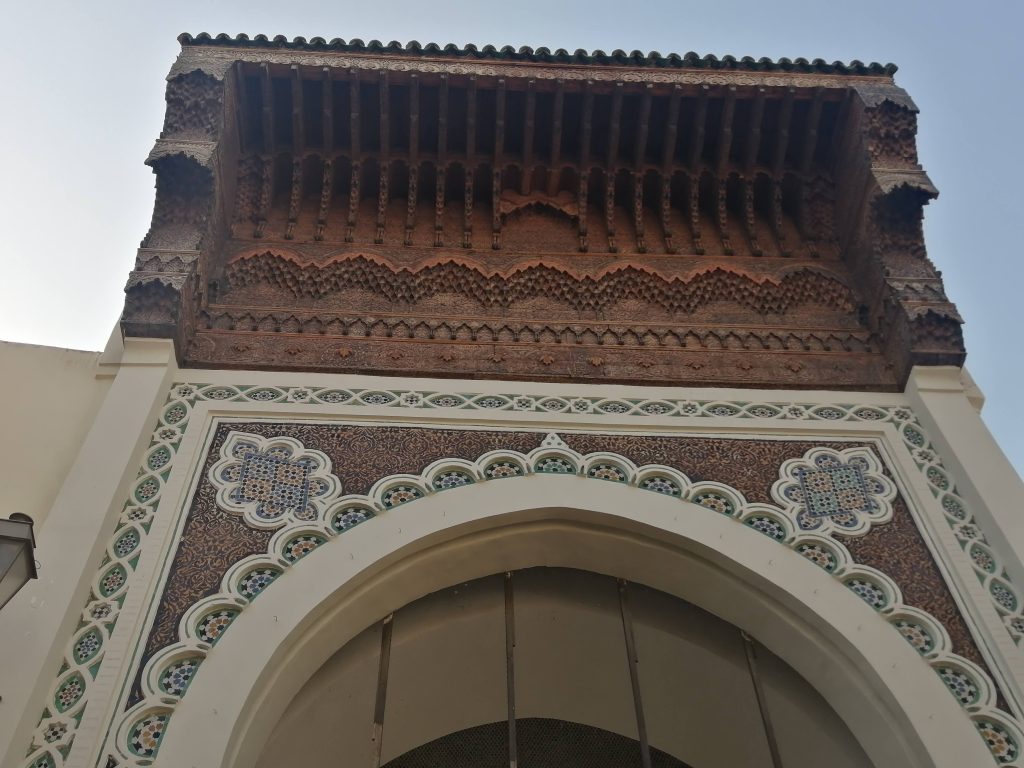
Detail of the facade of Andalusian mosque in Fez. Beautiful tile work & cedar wood carvings.
Unfortunately we – as non-muslims – couldn’t admire the mosque from the outside, nor have a peek inside through the main gate which was still closed when we passed. Still though, an impressive building.
Zawiya/Zaouia of Moulay Idriss II
In this religious building you’ll find the shrine of Idris II, son of Idris I (the founder of Fez, although some people consider his son the real founder).
- Idris I is buried in Zerhoun – not far from Fez (see below).
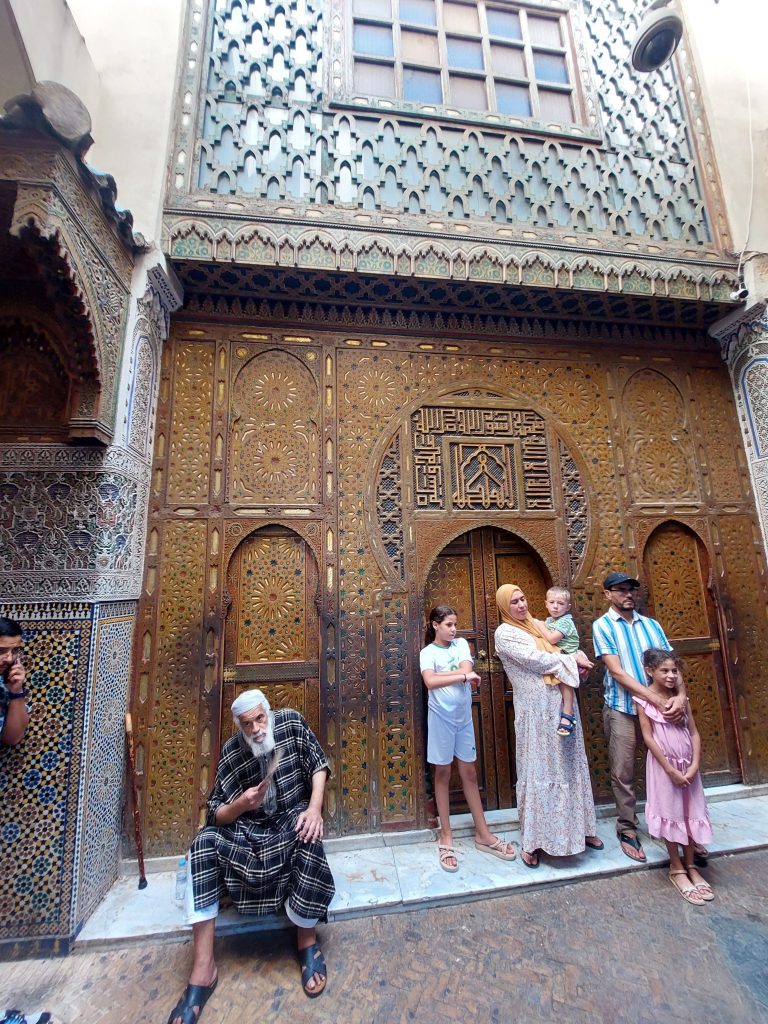
Front view of the beautiful Zawiya of Moulay Idriss II, Fez.
Visit Fez: Other monuments we saw in & around the medina
As our guided tour was set for the morning hours we only visited the most important monuments not too far from our hotel. Others we visited later on.
Bab Bou Jeloud
This iconic gate is one of the main entrances to the medina of Fez. It’s decorated with beautiful blue & green tiles, and it’s a popular spot to take pictures.
- Blue is the color of the sky & the sea, and is generally associated with peace, tranquility & spirituality. However, in the case of Fez also linked to its pottery, which is painted with elegant cobalt blue designs.
- Green is the color of Islam, and it is associated with nature, fertility, prosperity, and paradise.
- It was the French who decided to leave the city with this artful Moorish entrance to the old city & medina. It was built in 1913, a year after Morocco became a French Protectorate. The gate replaced an older one. A simple, modest gate, dating from the 12th century,
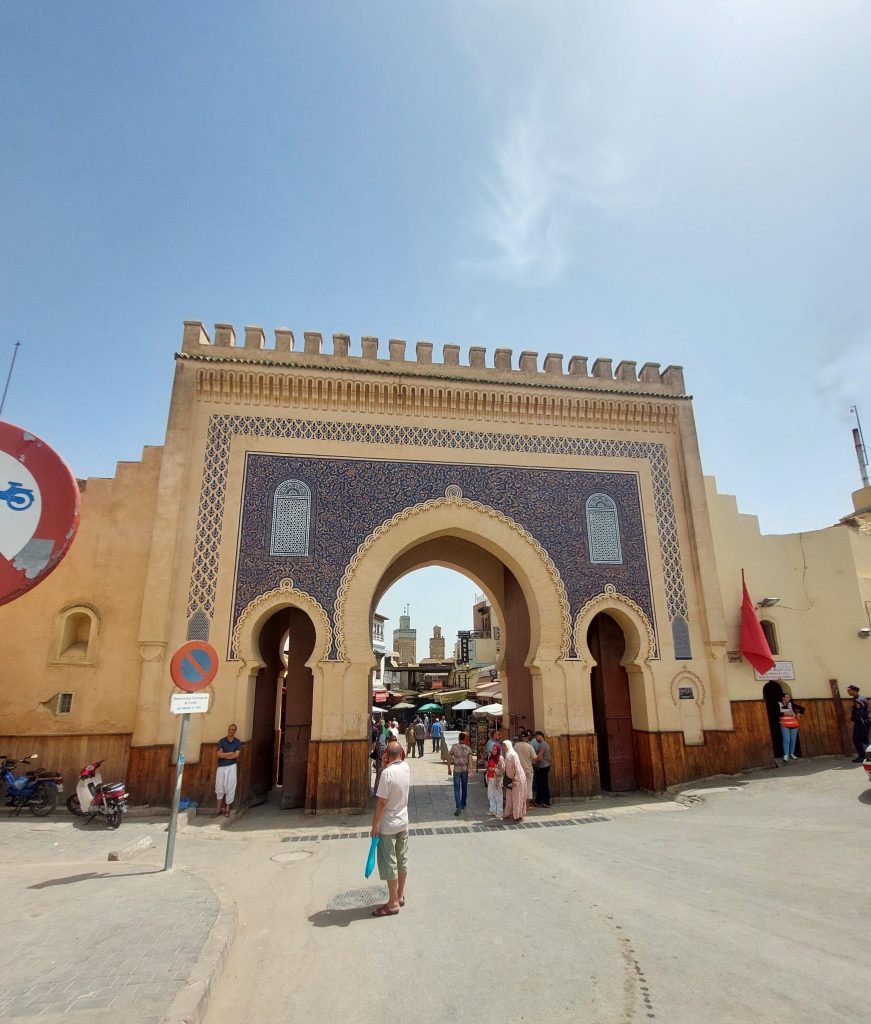
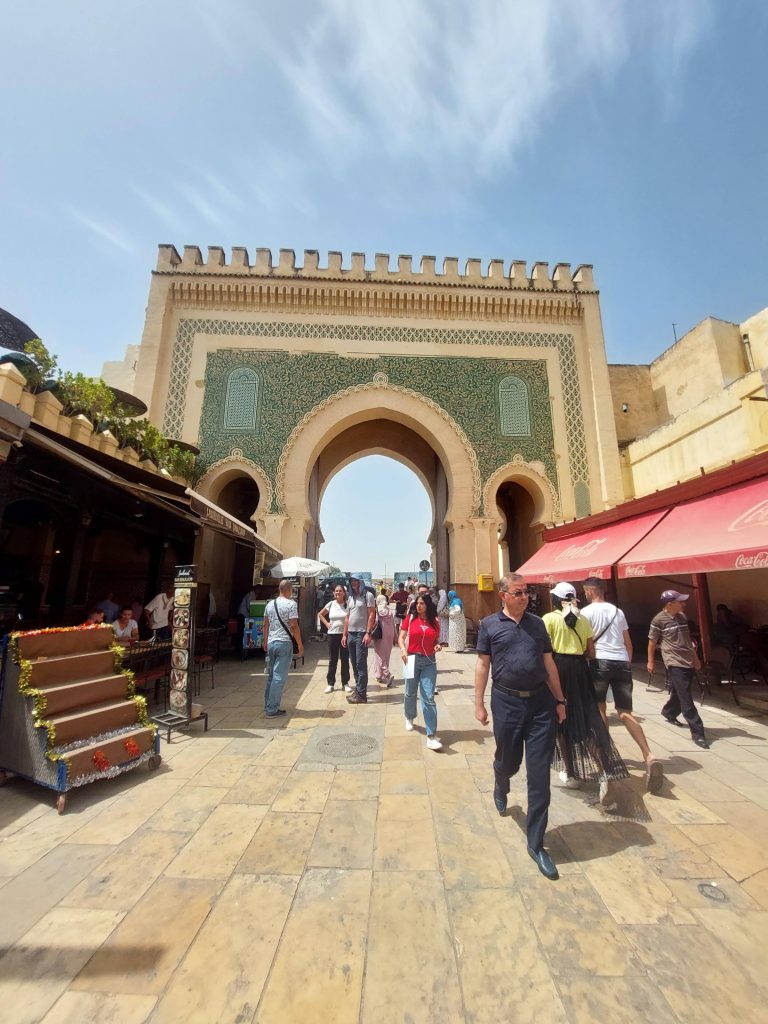
Exterior (blue) & Interior (green) view of one of the main gates to the medina of Fez.
The Bab Bou Jeloud is also the main gate for tourists. While on “our side” – that is, where we stayed the night – we mainly met other foreign visitors in our hotel, on this side we saw plenty. Reason also why there were more shops & restaurants in this part of the medina. A lively part for sure.
Soon enough a group of colorful musicians accompanied all us visitors. A trance-like performance which was appreciated by tourists & locals alike. The local inhabitants told us the music was made by “people from the south” – the Sub-Saharan region of Africa.
- These people are called Gnawa. They were brought to Morocco as slaves in the 15th & 16th century, but are still holding on to their old traditions, like their music – Gnawa music.
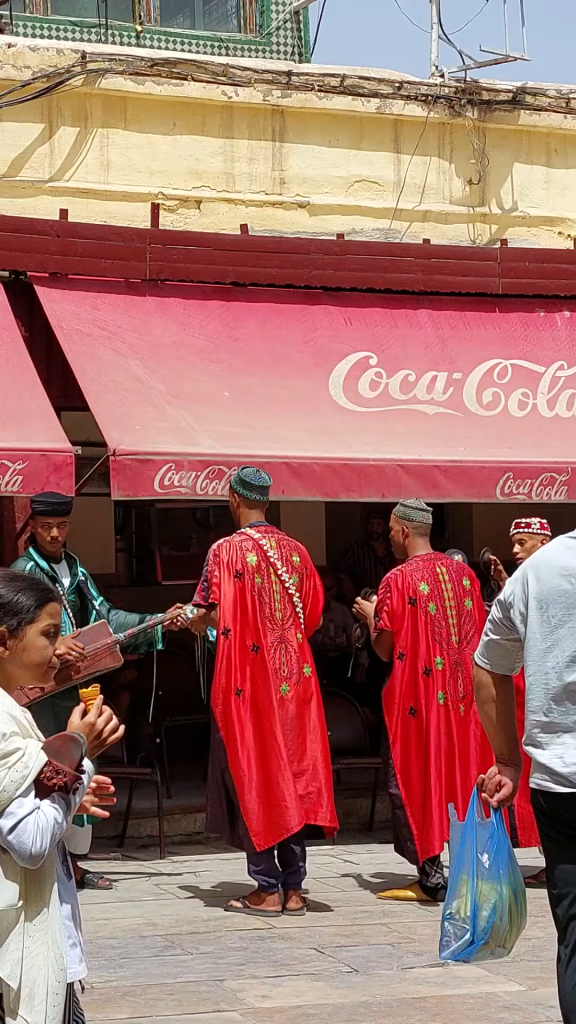
Gnawa-musicians in Fez, Morocco.
Jnan Sbil or Bou Jeloud Garden
This peaceful garden – created in the second half of the 19th century- is located very near the Bab Bou Jeloud gate, on the border of Fes El Bali & Fes El Jdid.
- The two neighborhoods who ultimately form the old city center of Fez. The Fes El Jdid is actually a 12th century extension of the Fes El Bali.
The park is a perfect spot to relax a little & rest from the busy alleyways & the hot climate. Entrance to gardens is FREE.
TRAVELTip: While visiting the garden we could convince ourselves soon enough of its beauty, but also that it had suffered a lot because of the hot & dry climate. That said, it’s still worth your visit. If not, for the small terrace we found near the gate (across the street), for a drink and a bite. Just what we needed at the moment.
- Everywhere you go in Morocco, you spot people – mostly men – sitting on terraces. Sometimes it seems like that’s all they do, but that’s not true. Most of them drink or share a cup of tea. Mint Tea. You’ll get that everywhere – with or without sugar. Very refreshing!
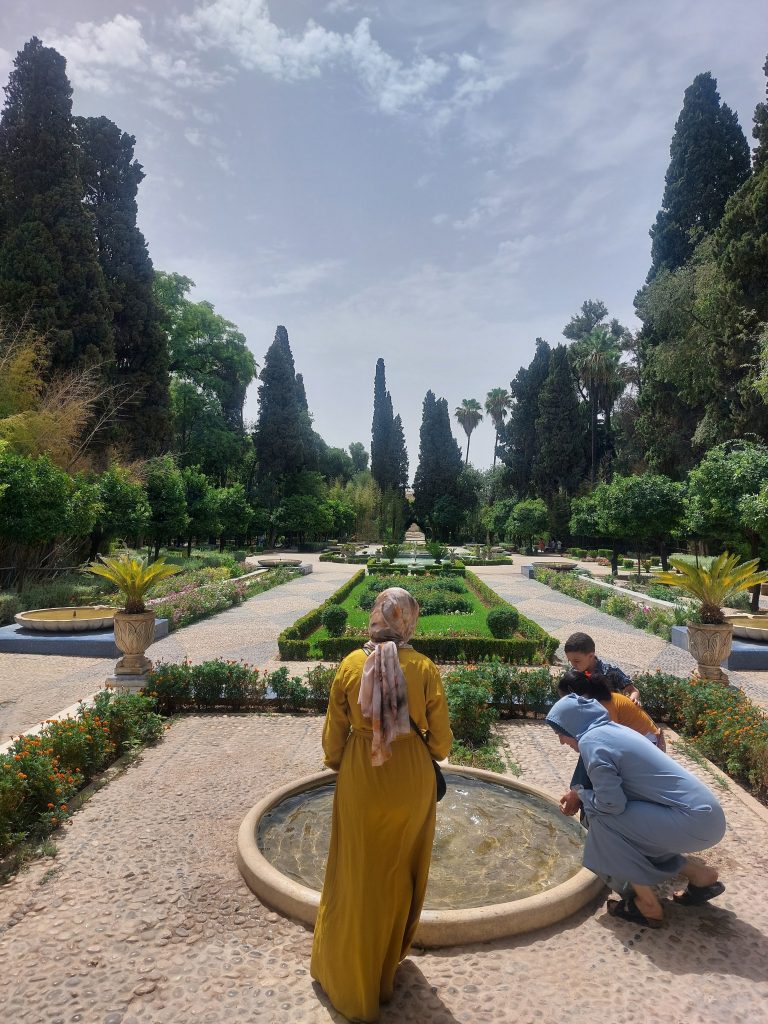
Jnan Sbil or Bou Jeloud Garden, Fez.
Some other attractions to visit in & around Fez
Because of the lack of time & energy (it is HOT in August) we couldn’t visit other worthwhile attractions Fez has to offer. Which of course doesn’t mean I can’t present them to you.
The Jewish quarter of Fez
This historical Jewish neighborhood (Mellah) is also located in the heart of the medina. The Jnan Sbil Garden – mentioned here above – is actually at the heart of it.
- This particular Mellah was founded in the 15th century and once home to a thriving Jewish community. Today, only a small number of them are left. The large majority left for Israel after the Second World War.
Besides the garden mentioned, other highlights in this quarter of the medina are: the Ibn Danan Synagogue (open to the public), the Jewish Cemetery (with over 10,000 tombstones) & the impressive Mellah Gate.
The Nejjarine Museum
The Nejjarine museum is dedicated to the Moroccan art of wood carving. It’s housed in a beautiful 17th-century caravanserai – a former roadside-inn, which in the past were scattered all along the major trade routes through Morocco.
- Dar Batha Museum: This “was” another famous museum in Fez. This one full of archaeological & historical artifacts. However, unfortunately it is closed for a couple of years now for unknown reasons. Hopefully it opens its gates again soon.
The Royal Palace
This is the place where the Royal family spends its nights when on a visit to Fez. Also only for outside views, as the palace is closed to the public in general. Still, the main gate is worth a quick visit & a few photo ops.
- The Royal family has palaces in all the major cities of Morocco (Marrakech, Fez, Tangier & Rabat). Besides the one in Fez, we could admire the one in Tangier later on. That is, also from the outside.
- The one in Fez is one of the biggest, with extensive gardens & ponds. It’s one of the greenest areas of Fez & for that reason one of the few places where you can spot storks all year round, as most of them leave for Europe during the Infernal Summer. In all, a wonderful sight.
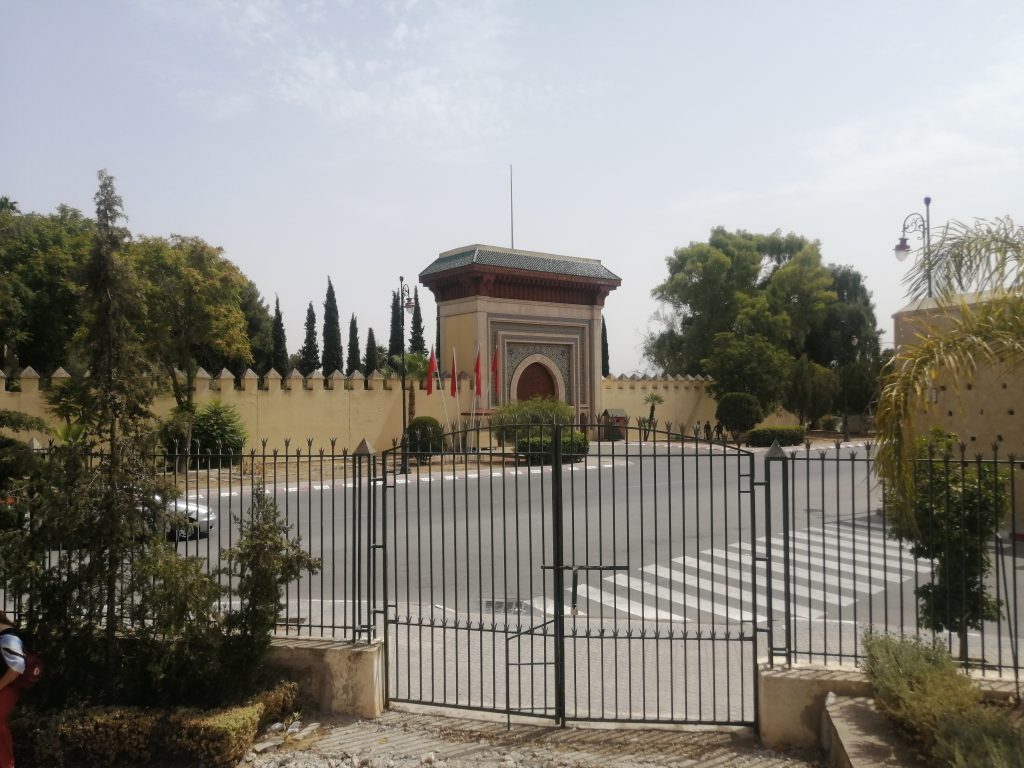
One of the side gates of the Royal palace in Fez.
Hammam Fez
Last, but not least, I’d like to present to you a traditional bath house. A perfect way to relax in Islamic fashion. If you want to do it the right way, you may include a massage & light food (see below).

Interior of the Hammam of Fez.
To learn more, go to: Relax at the luxurious Hammam of Fez (including a Massage, Beauty Treatment & Tapas Menu).
Attractions at the outskirts of Fez
Marinid Tombs
Just outside the city walls, on a hill, you’ll find the Marinid Tombs. Although the tombs are mostly ruined, the site is historical & you’ll get beautiful views of the city below.
- The Marinids ruled the country for three centuries after conquering Fez (1248 AD), making it their capital.
Borj Nord
A 17th-century fortress that offers stunning views of the city. The fortress is located on a hilltop (entrance is 20 Dirham, as it houses an interesting military collection). It’s just a short, but warm hike up from Fez’ city center – and it’s a popular spot for a picnic.
- There are actually two historical fortresses around the city. The Borj Sud is the other one. Smaller, less popular, but also impressive & open to the public. In this case FREE of charge.
Visit Fez: Shopping in the medina
As stated in my description of our first day medina tour, the guide brought us to the best shops in town. Souks which still produce authentic handicrafts. Something you may miss when staying in the touristic areas only, be it Fez, Marrakech, Tangier or another destination you visit while in Morocco.
- Unfortunately this happens in many places around the world. My hotel/restaurant is located in the Andean market town of Otavalo – housing the biggest handicraft market of Ecuador & Latin America (see, About Me). Although you still find beautiful & cheap artifacts on the Otavalo market, you have to look very close to still find real authentic products. Over here, it’s also better to go directly to the workshops.
So, I guess we were lucky. As we didn’t know this beforehand. Our guide really knew where to find the best shops in town, with affordable quality products.
To learn more, click on: A private shopping tour of the Fez’ medina
Hotel-tip Fez







Impressions of our hotel at the “other side” of the medina.
We all were very happy with the Hotel or Riad we stayed at. A beautiful historical building really. It felt like staying in a palace. The administrators told us it’s owned by a Frenchman who years ago restored this enormous family home to its former glory.
Positives:
- Good price (middle segment),
- Including a great breakfast
- FREE wifi (all the place)
- A relaxing atmosphere
- In an authentic part of the medina
- Cozy & lazy rooftop terrace with great views all around
- Swimming pool (!), open almost 24/7
- Friendly personal
- Great service (we could even order a beer, which isn’t always that easy in Morocco).
Negatives:
- Only disadvantage was the fact they didn’t – at the time we were there – accept credit cards. Only cash & their exchange rate was rather high (Pay them in euros, if you can. Or else, beforehand).
Still though, worth your visit/stay when in Fez.
If you want to learn more, click on: Riad Jamaï, Fez
Food/restaurants in Fez
As I explained earlier on – in my Introduction to Morocco – the local cuisine is known as straightforward! In other words, tasty, fresh & healthy (lots of vegetables & always accompanied with bread, olives & olive oil).
The most popular plates for you & us to try were: tajines or tagines (slow-cooked stews, prepared & presented in earthenware pots), couscous (a dried & cracked pasta made from wheat), pastilla (a pastry pie).
It wasn’t hard to find food nearby. The medina is full of smaller food shops (lots of bakeries, with bread & all kinds of cookies, but also sandwiches, salads, et cetera). When it came to finding a restaurant for lunch & dinner no problem either.
We ate at several traditional places, but I will only mention the best one we’ve visited in Fez. Mainly because it deserves the mention, namely the Restaurant Bouanania near the Bab Bou Jeloud, the Blue gate (at the left hand side, after entering). Although busy – with foreigners & locals alike – we were lucky enough to occupy a table on the rooftop terrace.
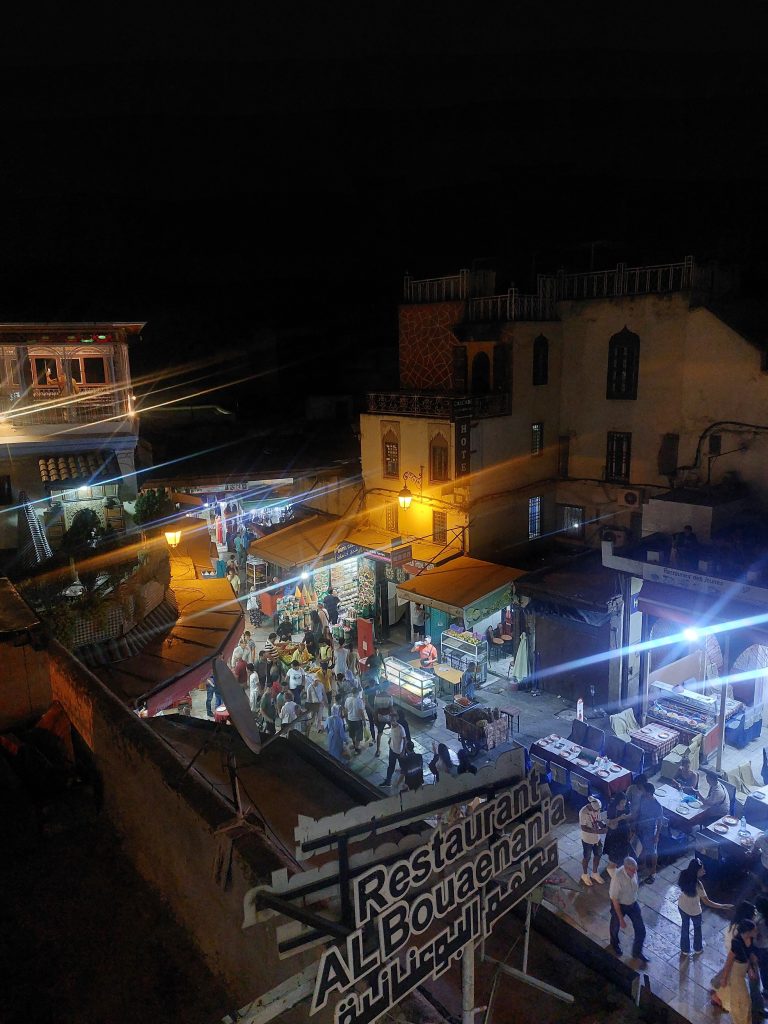
View from the rooftop terrace of Restaurant Bouanania, near the Blue Gate in Fez.
Popular tours in & day-trips from Fez
Here’s a list of the most popular tours in & day-trips around Fez.
If travelling in the high season – November to March, but also in July & August – I’d recommend you to book a tour well in advance. First of all to be sure, and secondly to avoid stress when you least need it.
TRAVELTip: Click on the highlighted names (orange) to learn more about a certain tour or day-trip: (That is: a detailed description, duration, price, photos, as well as reviews from earlier participants.)
Visit Fez: Medina Walking Tour
As mentioned above, you can explore the medina on your own, but I’ll recommend you to start with a guided tour. A tour with a professional local guide who can tell you all about Fez’ past & present. Who can lead you to the most important monuments, but also the best shops, and – also very important – back to your hotel.

Impression of the medina of Fez.
To get acquainted with the labyrinthine old city center of Fez, the following tour is a great option. Besides the main historical attractions – like the Al-Qarawiyyin Mosque & University, the Andalusian Mosque, the Tannery – you’ll visit several authentic handicraft shops.
To learn more, go to: Fez Medina Walking Tour
Roman ruins of Volubilis
This popular UNESCO World Heritage Site is located to the West of Fez. The shortest route is 83km/52mi., a 1,5 hours ride.
Volubilis is one of the most important archaeological sites in Morocco. It’s definitely Roman in outlook, but the earliest remains are older yet.
- The city was founded in the 3rd century BC by local Berber tribes. In the first century it served shortly as the capital of the Kingdom of Mauretania under Juba II, ally of Rome.
- After Juba’s death Tiberius incorporated Mauretania into the Roman Empire, with Volubilis as its capital. The town was a thriving center of trade & commerce, home to a mixed population of Romans, Berbers & Jews.






Impressions of our visit to the former Roman city of Volubilis, near Fez.
- After the Arab invasion the founder of Morocco’s first dynasty Idris I used Volubilis shortly as its base, renaming it Walili (Oualili). Soon after though he named Fez the Royal capital, after which Volubilis was abandoned & left to convert itself – little by little – into the ruined city it is today.
A visit to the Roman ruins of Volubilis
The ruins of Volubilis are generally well-preserved, providing a fascinating glimpse into the city’s history. The site includes the remains of a forum, a basilica, a temple, a theater & several private homes. Further on, you can admire several unique & still colorful mosaics at the site.
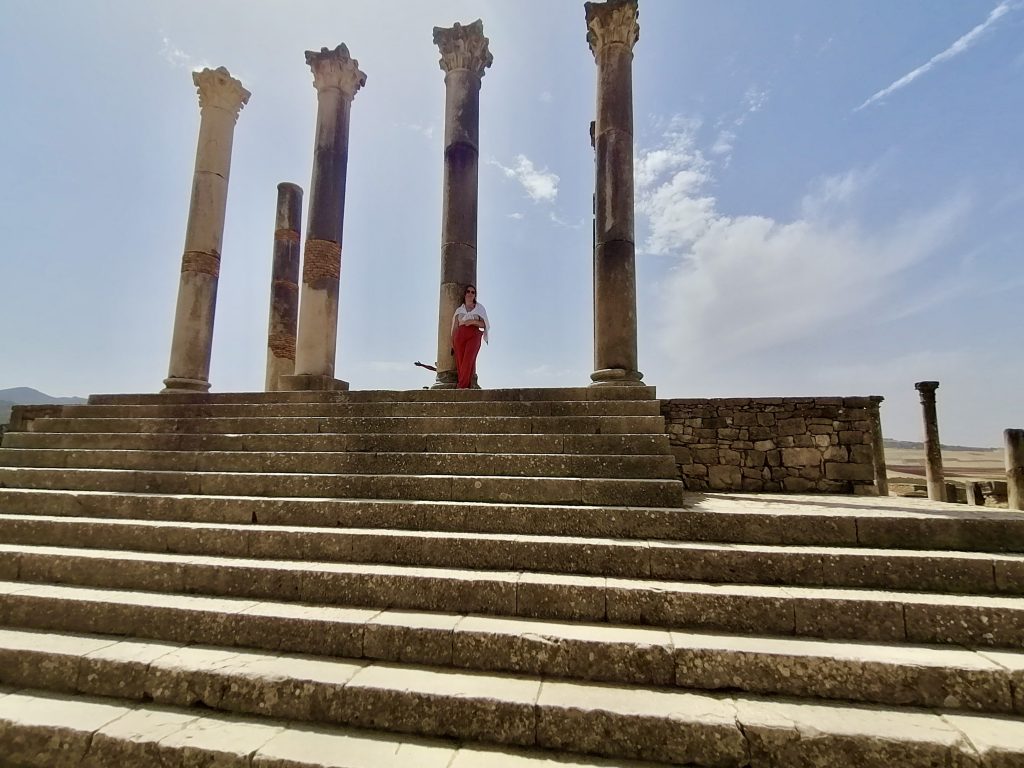
Volubilis is a popular tourist destination. Besides the Roman remains, there’s an interesting museum as well, telling the town’s story & housing many wonderful artifacts found at the site.
- Entrance to the site & museum is 60 Dirham for foreigners.
WARNING: As the site is located up a hill without too much shade, prepare yourself. Protect yourself (sun block, clothing, cap, hat, sunglasses maybe). Bring water. More so, when you visit Morocco during the hottest months (June, July & August).
TRAVELTip: Many people combine a visit to Volubilis with visits to Moulay Idris Zerhoun (see below).
The Holy City of Moulay Idriss Zerhoun
Only 5km/3mi. from Volubilis is located the Holy city of Moulay Idriss Zerhoun. A town which is mainly known for the presence of the tomb of Idris I, the first Islamic ruler of Morocco.
For that reason it’s a pilgrimage site for muslims. Non-muslims are allowed to enter the site, but they can’t enter the inner sanctum of the tomb (only view it from the outside).
Absolutely worth a visit, as the city itself is Morocco’s umpteenth UNESCO World Heritage Site. Besides the town’s narrow streets, whitewashed houses & stylish architecture, the views of the surrounding area are impressive as well.

Overview of the Holy City of Moulay Idriss Zerhoun. In the foreground is the mosque containing the tomb of Idris I.
The Imperial city of Meknes
Further southward – about 30 km/18.6mi. – you will find the city of Meknes.
- Meknes was another former capital of Morocco. For that reason it is also one of the four Imperial cities of Morocco, together with Fez, Marrakech & Rabat. And again a UNESCO World Heritage Site.
The inner city of Meknes is mainly known for its unique architecture, like the impressive Bab Mansour gate. As well as the beautiful Mausoleum of Moulay Ismail, the sultan who decided Meknes – instead of Fez – would be Morocco’s capital (That is, from 1672 until his death in 1727).
The mausoleum is open to the general public. The inner sanctum with the tomb only for Muslims.

The Bab Mansour gate in Meknes.
Meknes’ medina is much smaller than the one in Fez, but certainly one of the most beautiful in Morocco. The narrow streets are lined with traditional Moroccan shops (souks) & cafes.
TRAVELTip: Many people combine a visit to Meknes with a visit to Volubilis & Moulay Idriss Zerhoun. You can do that on your own if you have a rental car or a personal driver. If not, I’d recommend you to organise a tour from Fez with a local guide.
To learn more, go to: Tour of Volubilis, Moulay Idriss Zerhoun & Meknes
Chefchaouen, the Blue City
Another highly popular tour from Fez is a full day-trip to Chefchaouen, also known as The Blue City or The Blue Pearl. A charming small town at the foot of the Rif Mountains & a must-visit for anyone who’s exploring this part of Morocco.
- Chefchaouen (Berber) means “look at the horns”, referring to the twin peaks who stand guard over the city – the Jebel Megou & the Jebel Hassani.
Besides being a beautiful, clean city, it’s also a very relaxing destination. Easy going, with lots of terraces & friendly people.
If you didn’t choose to stay in Chefchaouen for a few days – like we did – I’d recommend you to visit the city for at least a day. Several well organised day-trips are organised from Fez (Or else, also from Tangier or Casablanca).
To learn more, click on:
*Beforehand we considered Chefchaouen special enough to plan 3 nights there. I’ll tell you all about it in the following post (still under construction, but ready soon).
Middle Atlas & Berber Villages
Finally, I’ll present you two outdoor activities you can easily undertake from Fez:
- One to visit the Middle Atlas Mountains near Fe
- The other one to cross over these mountains to the Sahara Desert
The Middle Atlas Mountains are a great place for all sorts of outdoor activities: hiking, biking, horseback riding or skiing (in winter). An area full of small Berber villages & nature reserves.
If you don’t plan to stay there or don’t have your own (or rented) car, there’s the option to book A tour from Fez. These tours generally include stops at several Berber places which give you the chance to learn more about the local culture, centuries old traditions, but also about the beautiful handicrafts these mountain villages produce & sell.
Besides these villages, there’s often a visit also to the beautiful cedar forests near Azrou, home to – amongst other animals – the famous Barbary macaques (also known for their presence on the Rock of Gibraltar).


Visit to the cedar forest near Azrou, home of the Barbary monkeys.
To learn more, click on: Middle Atlas Tour from Fez
A visit to the Sahara Desert near Fez
The Sahara Desert is one of the most popular tourist destinations in Morocco.
Most people include a visit to the desert from Marrakech, but there’s also the option to book A Sahara tour from Fez.
Most of these tours set out for a 2 day/1 night trip to Merzouga – a small village near the border with Algeria. Base for your explorations of the desert – on camel-back. More specifically the sky-high sand dunes of Erg Chebbi.
To get there you have to cross the high peaks of the Middle Atlas, making stops along the way. Concretely several Berber villages, but also a forest where you’ll meet up with the local Barbary Monkeys.
In short, a great way to learn how people live their lives in the Moroccan desert & Atlas mountains.
To learn more, click on: Desert-tour from Fes
Besides a 1 night tour, GetYourGuide also offers a 2 night tour, starting in Fez but ending up in Marrakech.
To learn more, click on: Desert Tour from Fez to Marrakech
Our visit to Fez in a few words
We were all very glad we chose Fez as our starting point of our 10-day journey through Morocco. The perfect place to get to know Morocco from the inside. Well, that’s urban Morocco of course.
Fez is an authentic Moroccan city, with a unique, somewhat mysterious vibe & a palpable local culture. Beside its interesting past we found in Fez the old handcraftsmenship you always hear mention when you talk about Morocco.
Sure, a busy, infernally hot city like Fez is also confronting, but that was just part of the deal & just where we were looking for. Learn about another world with another past, outlook & culture.
Besides that, we knew beforehand that our visit to Fez would be limited. After a few busy & exciting days in one of the biggest cities of Morocco we would go on & get a better idea of the countryside & lesser busy destinations, namely:
Click on their names to learn more about our experiences over there:







The lively vibe of the medina of Fez.


For an overview of all travel posts of my blog, go to: the Home Page.

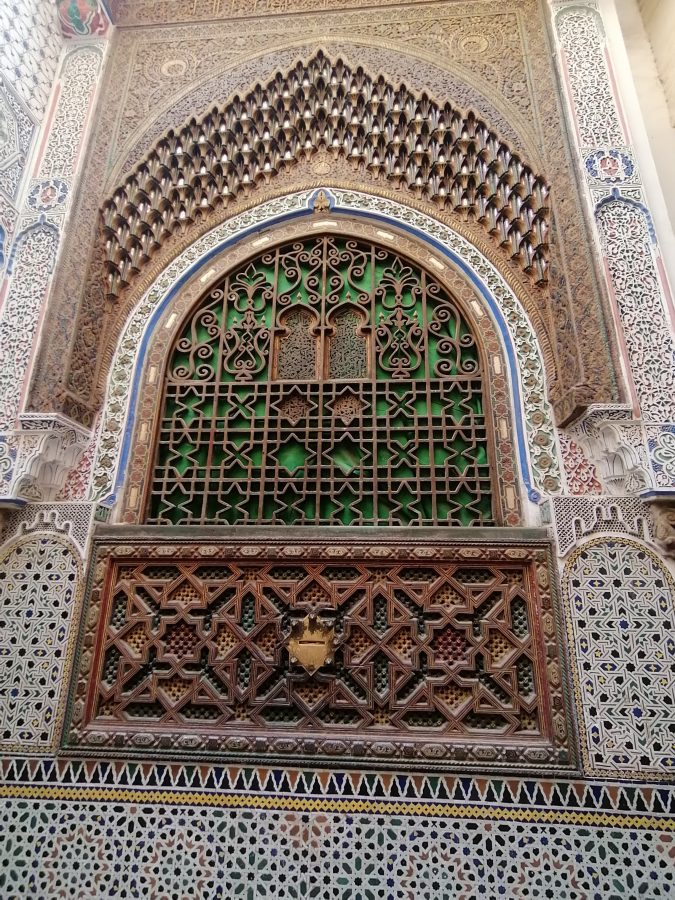
Comments
3 responses to “The best tips & ideas for a perfect visit to the beautiful city of Fez”
[…] The best tips & ideas for a perfect visit to the beautiful city of Fez […]
[…] The best tips & ideas for a perfect visit to the beautiful city of Fez […]
[…] The best tips & ideas for a perfect visit to the beautiful city of Fez […]